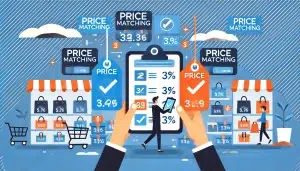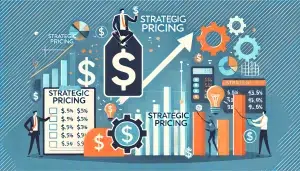Unleash the full potential of pricing tools amidst high inflation in this in-depth guide, delving into both the art and science behind optimal approaches.
The surge in inflation rates across the globe has presented businesses with a unique set of challenges when it comes to pricing their products and services. With the Consumer Price Index reaching levels not seen in decades, companies are faced with the daunting task of striking a balance between maintaining profitability and keeping their offerings accessible to consumers.
As the ecommerce landscape continues to evolve, businesses should explore innovative pricing models that can provide a competitive edge. Dynamic pricing, subscription-based models, and bundling strategies are just a few examples of innovative approaches that can help retailers adapt to the changing market dynamics and maintain their profitability.
Understanding the Impact of Inflation on Business
The effects of inflation can be far-reaching, impacting businesses of all sizes and across various sectors. From the rising costs of raw materials and labor to the changing consumer spending patterns, inflation can disrupt the delicate balance of supply and demand, forcing companies to re-evaluate their pricing strategies.
The challenges posed by inflation extend beyond mere cost increases and many business onwers fear that supply chain shortages will negatively impact the health of their businesses. This cost burden can quickly erode profit margins, compelling businesses to pass on these increases to their customers or worse, business closure.
Leveraging Data-Driven Insights
Data-driven decision-making is paramount in times of high inflation. By harnessing advanced analytics and pricing solutions, ecommerce businesses can gain a comprehensive understanding of their customers’ behavior, price sensitivity, and the competitive landscape. This knowledge empowers them to make informed, data-backed pricing decisions that optimize profitability while maintaining customer loyalty.
Precision Pricing: The Key to Navigating Inflation
Rather than viewing inflation as a negative and insurmountable hurdle, businesses should leverage it as an opportunity to optimize pricing models and strengthen their competitive position.
One of the most effective approaches is known as “precision pricing.” This strategic framework enables businesses to tailor pricing tools to the unique needs and profitability of each product and customer segment, rather than relying on across-the-board price increases.
Determining Actual Costs and Profits
The foundation of precision pricing lies in understanding the true, current costs and profitability of each product and customer. Traditional methods that rely on standard costs and aggregate profit metrics often fail to capture the nuances of an inflationary environment, where input costs can fluctuate rapidly and unpredictably.
This approach necessitates a granular analysis of cost components and real-time adjustments to pricing tools, ensuring that businesses can respond swiftly to market changes and maintain their competitive edge.
Leveraging Enterprise Profit Management (EPM)
By implementing an Enterprise Performance Management (EPM) system, businesses can gain unprecedented visibility into their true, up-to-date cost structures and customer profitability. This digital solution generates detailed, transaction-level profit and loss statements (P&Ls) so outdated standard costs can be replaced with real-time, accurate data.
With this enhanced insight, companies can make more informed decisions, optimize resource allocation, and strategically adjust their pricing tools to maximize profitability.
Prioritizing Profit Peak and Profit Drain Customers
With the insights provided by the EPM system, companies can identify their most profitable (profit peak) and least profitable (profit drain) customer segments. This information allows them to tailor their pricing strategies accordingly, focusing on preserving the profitability of their top-performing accounts while addressing the needs of their less profitable ones.
By doing so, businesses can enhance their overall margin and ensure that resources are allocated efficiently. This targeted approach enables companies to develop customized marketing and sales strategies, improving customer retention and satisfaction across all segments.
Identifying Key Value Items (KVIs)
A critical component of effective pricing tools is the identification and management of Key Value Items (KVIs). These are the frequently purchased, high-volume products that are highly price-sensitive for consumers. By carefully analyzing KVIs and adjusting prices accordingly, businesses can strike a balance between maintaining customer satisfaction and preserving profit margins.
Cost-Plus Pricing
This model involves calculating the total cost of producing a good or service and then adding a predetermined profit margin to arrive at the final price. While simple to implement, cost-plus pricing requires careful analysis to ensure that the markup percentage remains competitive.
It requires regular reviewing and adjusting the markup to account for changes in production costs, market conditions, and competitor pricing. Without such diligence, businesses risk setting prices that are either too high, potentially driving customers away, or too low, which could erode profit margins. Therefore, although cost-plus pricing is easy to understand and apply, it demands ongoing vigilance to maintain its effectiveness in dynamic market environments.
Dynamic Pricing
Dynamic pricing models use advanced algorithms to adjust prices based on factors such as competitor pricing, supply chain disruptions, and changing consumer demand. This approach allows businesses to respond quickly to market fluctuations and optimize their pricing in real-time. By leveraging data analytics and machine learning, companies can predict trends, identify pricing opportunities, and minimize risks associated with price volatility.
This real-time adaptability not only enhances profitability but also improves customer satisfaction by offering competitive and fair prices. Furthermore, dynamic pricing enables businesses to efficiently manage inventory levels and respond to shifts in consumer behavior, ensuring sustained market relevance and competitive advantage.
Competitive Pricing
Monitoring and aligning prices with industry competitors can be an effective strategy, particularly for products that have reached a pricing equilibrium. By keeping a close watch on competitor pricing, businesses can ensure they remain competitive without undercutting their profit margins. This approach helps businesses maintain their market position while passing on cost increases to consumers, thereby safeguarding profitability.
Additionally, aligning prices with the industry standard can foster customer trust and loyalty, as consumers perceive the pricing to be fair and consistent. However, it is crucial for businesses to continually assess market conditions and competitor actions to make timely adjustments and avoid potential pitfalls associated with rigid pricing strategies.
Proactive Contracting and Customer Screening
Businesses should carefully screen for products and services that are susceptible to volatile input costs, such as petroleum-based raw materials or ocean shipping. By incorporating escalators or guardrails into these agreements, companies can ensure that prices automatically adjust to reflect significant cost increases, protecting their profitability.
This sort of screening will enable analysis of prospective customers, allowing sales teams to identify and avoid accounts that are overly exposed to major cost fluctuations and have a history of resisting pricing adjustments.
Communicating Price Increases to Customers
Transparency and clear communication are essential when implementing price increases. Ecommerce businesses should proactively inform their customers about the reasons behind the price adjustments, such as rising material costs or supply chain challenges. By providing a rational and empathetic explanation, businesses can mitigate the risk of customer backlash and strengthen their brand’s reputation.
Enhancing Brand Perception and Customer Loyalty
Inflation also has a profound impact on consumer behavior. As prices rise, customers become more price-conscious, often seeking out more affordable alternatives or reducing their overall spending. This shift in consumer sentiment can make it challenging to maintain customers and sustain revenue growth.
It’s about prioritizing and maintaining a strong brand image to foster customer loyalty. By defining a clear brand identity, offering exceptional customer support, and delivering consistent value, retailers can mitigate the negative impact of inflation and position themselves as trusted partners in the eyes of their customers.
Adapting Pricing Tools Over Time
Keep in mind that pricing strategies during inflationary periods are not static; they require continuous monitoring, evaluation, and adjustment. Ecommerce businesses must remain agile, closely tracking market trends, customer feedback, and the impact of their pricing decisions. By regularly revisiting and refining their approaches, retailers can ensure that their pricing strategies remain relevant and effective in the face of evolving economic conditions.
While the temptation to maximize short-term profits during inflationary periods may be strong, businesses must exercise caution. Striking the right balance between immediate revenue generation and long-term customer retention is crucial.
The Road Ahead: Embracing Pricing Tools and Discipline
As businesses navigate the challenges of high inflation, the ability to develop and implement effective pricing tools will be a crucial differentiator. By embracing the principles of precision pricing, leveraging a diverse range of pricing models, and complementing these strategies with cost-saving measures and enhanced customer communication, companies can not only weather the current storm but also position themselves for long-term success.
The road ahead may be paved with uncertainty, but by cultivating a disciplined, data-driven approach to pricing, businesses can turn inflation into an opportunity to strengthen their competitive edge, improve profitability, and deepen their relationships with valued customers.




